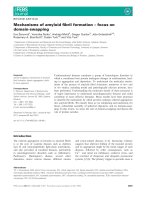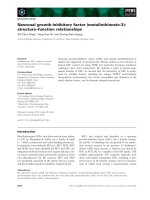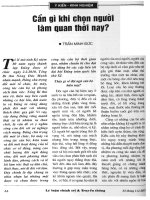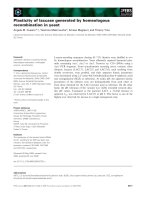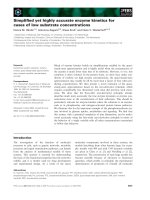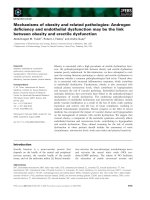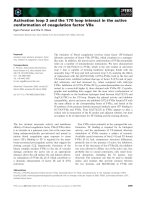Tài liệu Báo cáo khoa học: "HITS-based Seed Selection and Stop List Construction for Bootstrapping" doc
Bạn đang xem bản rút gọn của tài liệu. Xem và tải ngay bản đầy đủ của tài liệu tại đây (114.16 KB, 7 trang )
Proceedings of the 49th Annual Meeting of the Association for Computational Linguistics:shortpapers, pages 30–36,
Portland, Oregon, June 19-24, 2011.
c
2011 Association for Computational Linguistics
HITS-based Seed Selection and Stop List Construction for Bootstrapping
Tetsuo Kiso Masashi Shimbo Mamoru Komachi Yuji Matsumoto
Graduate School of Information Science
Nara Institute of Science and Technology
Ikoma, Nara 630-0192, Japan
{tetsuo-s,shimbo,komachi,matsu}@is.naist.jp
Abstract
In bootstrapping (seed set expansion), select-
ing good seeds and creating stop lists are two
effective ways to reduce semantic drift, but
these methods generally need human super-
vision. In this paper, we propose a graph-
based approach to helping editors choose ef-
fective seeds and stop list instances, appli-
cable to Pantel and Pennacchiotti’s Espresso
bootstrapping algorithm. The idea is to select
seeds and create a stop list using the rankings
of instances and patterns computed by Klein-
berg’s HITS algorithm. Experimental results
on a variation of the lexical sample task show
the effectiveness of our method.
1 Introduction
Bootstrapping (Yarowsky, 1995; Abney, 2004) is a
technique frequently used in natural language pro-
cessing to expand limited resources with minimal
supervision. Given a small amount of sample data
(seeds) representing a particular semantic class of
interest, bootstrapping first trains a classifier (which
often is a weighted list of surface patterns character-
izing the seeds) using the seeds, and then apply it on
the remaining data to select instances most likely to
be of the same class as the seeds. These selected in-
stances are added to the seed set, and the process is
iterated until sufficient labeled data are acquired.
Many bootstrapping algorithms have been pro-
posed for a variety of tasks: word sense disambigua-
tion (Yarowsky, 1995; Abney, 2004), information
extraction (Hearst, 1992; Riloff and Jones, 1999;
Thelen and Riloff, 2002; Pantel and Pennacchiotti,
2006), named entity recognition (Collins and Singer,
1999), part-of-speech tagging (Clark et al., 2003),
and statistical parsing (Steedman et al., 2003; Mc-
Closky et al., 2006).
Bootstrapping algorithms, however, are known to
suffer from the problem called semantic drift: as the
iteration proceeds, the algorithms tend to select in-
stances increasingly irrelevant to the seed instances
(Curran et al., 2007). For example, suppose we want
to collect the names of common tourist sites from a
web corpus. Given seed instances {New York City,
Maldives Islands}, bootstrapping might learn, at one
point of the iteration, patterns like “pictures of X”
and “photos of X,” which also co-occur with many
irrelevant instances. In this case, a later iteration
would likely acquire frequent words co-occurring
with these generic patterns, such as Michael Jack-
son.
Previous work has tried to reduce the effect of se-
mantic drift by making the stop list of instances that
must not be extracted (Curran et al., 2007; McIntosh
and Curran, 2009). Drift can also be reduced with
carefully selected seeds. However, both of these ap-
proaches require expert knowledge.
In this paper, we propose a graph-based approach
to seed selection and stop list creation for the state-
of-the-art bootstrapping algorithm Espresso (Pantel
and Pennacchiotti, 2006). An advantage of this ap-
proach is that it requires zero or minimal super-
vision. The idea is to use the hubness score of
instances and patterns computed from the point-
wise mutual information matrix with the HITS al-
gorithm (Kleinberg, 1999). Komachi et al. (2008)
pointed out that semantic drift in Espresso has the
same root as topic drift (Bharat and Henzinger,
1998) observed with HITS, noting the algorithmic
similarity between them. While Komachi et al. pro-
posed to use algorithms different from Espresso to
30
avoid semantic drift, in this paper we take advantage
of this similarity to make better use of Espresso.
We demonstrate the effectiveness of our approach
on a word sense disambiguation task.
2 Background
In this section, we review related work on seed se-
lection and stop list construction. We also briefly in-
troduce the Espresso bootstrapping algorithm (Pan-
tel and Pennacchiotti, 2006) for which we build our
seed selection and stop list construction methods.
2.1 Seed Selection
The performance of bootstrapping can be greatly in-
fluenced by a number of factors such as the size of
the seed set, the composition of the seed set and the
coherence of the concept being expanded (Vyas et
al., 2009). Vyas et al. (2009) studied the impact of
the composition of the seed sets on the expansion
performance, confirming that seed set composition
has a significant impact on the quality of expansions.
They also found that the seeds chosen by non-expert
editors are often worse than randomly chosen ones.
A similar observation was made by McIntosh and
Curran (2009), who reported that randomly chosen
seeds from the gold-standard set often outperformed
seeds chosen by domain experts. These results sug-
gest that even for humans, selecting good seeds is a
non-trivial task.
2.2 Stop Lists
Yangarber et al. (2002) proposed to run multiple
bootstrapping sessions in parallel, with each session
trying to extract one of several mutually exclusive
semantic classes. Thus, the instances harvested in
one bootstrapping session can be used as the stop
list of the other sessions. Curran et al. (2007) pur-
sued a similar idea in their Mutual Exclusion Boot-
strapping, which uses multiple semantic classes in
addition to hand-crafted stop lists. While multi-class
bootstrapping is a clever way to reduce human su-
pervision in stop list construction, it is not generally
applicable to bootstrapping for a single class. To ap-
ply the idea of multi-class bootstrapping to single-
class bootstrapping, one has to first find appropri-
ate competing semantic classes and good seeds for
them, which is in itself a difficult problem. Along
this line of research, McIntosh (2010) recently used
Algorithm 1 Espresso algorithm
1: Input: Seed vector i
0
2: Instance-pattern co-occurrence matrix A
3: Instance cutoff parameter k
4: Pattern cutoff parameter m
5: Number of iterations τ
6: Output: Instance score vector i
7: Pattern score vector p
8: function ESPRESSO(i
0
, A, k, m, τ )
9: i ← i
0
10: for t = 1, 2, , τ do
11: p ← A
T
i
12: Scale p so that the components sum to one.
13: p ← SELECTKBEST(p, k)
14: i ← Ap
15: Scale i so that the components sum to one.
16: i ← SELECTKBEST(i, m)
17: return i and p
18: function SELECTKBEST(v, k)
19: Retain only the k largest components of v, resetting the
remaining components to 0.
20: return v
clustering to find competing semantic classes (nega-
tive categories).
2.3 Espresso
Espresso (Pantel and Pennacchiotti, 2006) is one of
the state-of-the-art bootstrapping algorithms used in
many natural language tasks (Komachi and Suzuki,
2008; Abe et al., 2008; Ittoo and Bouma, 2010;
Yoshida et al., 2010). Espresso takes advantage of
pointwise mutual information (pmi) (Manning and
Sch
¨
utze, 1999) between instances and patterns to
evaluate their reliability. Let n be the number of all
instances in the corpus, and p the number of all pos-
sible patterns. We denote all pmi values as an n × p
instance-pattern matrix A, with the (i, j) element of
A holding the value of pmi between the ith instance
and the jth pattern. Let A
T
denote the matrix trans-
pose of A.
Algorithm 1 shows the pseudocode of Espresso.
The input vector i
0
(called seed vector) is an n-
dimensional binary vector with 1 at the ith com-
ponent for every seed instance i, and 0 elsewhere.
The algorithm outputs an n-dimensional vector i and
an p-dimensional vector p, respectively representing
the final scores of instances and patterns. Note that
for brevity, the pseudocode assumes fixed numbers
(k and m) of components in i and p are carried over
to the subsequent iteration, but the original Espresso
31
allows them to gradually increase with the number
of iterations.
3 HITS-based Approach to Seed Selection
and Stop List Construction
3.1 Espresso and HITS
Komachi et al. (2008) pointed out the similarity
between Espresso and Kleinberg’s HITS web page
ranking algorithm (Kleinberg, 1999). Indeed, if we
remove the pattern/instance selection steps of Algo-
rithm 1 (lines 13 and 16), the algorithm essentially
reduces to HITS. In this case, the outputs i and p
match respectively the hubness and authority score
vectors of HITS, computed on the bipartite graph of
instances and patterns induced by matrix A.
An implication of this algorithmic similarity is
that the outputs of Espresso are inherently biased
towards the HITS vectors, which is likely to be
the cause of semantic drift. Even though the pat-
tern/instance selection steps in Espresso reduce such
a bias to some extent, the bias still persists, as em-
pirically verified by Komachi et al. (2008). In other
words, the expansion process does not drift in ran-
dom directions, but tend towards the set of instances
and patterns with the highest HITS scores, regard-
less of the target semantic class. We exploit this ob-
servation in seed selection and stop list construction
for Espresso, in order to reduce semantic drift.
3.2 The Procedure
Our strategy is extremely simple, and can be sum-
marized as follows.
1. First, compute the HITS ranking of instances
in the graph induced by the pmi matrix A. This
can be done by calling Algorithm 1 with k =
m = ∞ and a sufficiently large τ .
2. Next, check the top instances in the HITS rank-
ing list manually, and see if these belong to the
target class.
3. The third step depends on the outcome of the
second step.
(a) If the top instances are of the target class,
use them as the seeds. We do not use a
stop list in this case.
(b) If not, these instances are likely to make a
vector for which semantic drift is directed;
hence, use them as the stop list. In this
case, the seed set must be prepared manu-
ally, just like the usual bootstrapping pro-
cedure.
4. Run Espresso with the seeds or stop list found
in the last step.
4 Experimental Setup
We evaluate our methods on a variant of the lexi-
cal sample word sense disambiguation task. In the
lexical sample task, a small pre-selected set of a tar-
get word is given, along with an inventory of senses
for each word (Jurafsky and Martin, 2008). Each
word comes with a number of instances (context
sentences) in which the target word occur, and some
of these sentences are manually labeled with the cor-
rect sense of the target word in each context. The
goal of the task is to classify unlabeled context sen-
tences by the sense of the target word in each con-
text, using the set of labeled sentences.
To apply Espresso for this task, we reformulate
the task to be that of seed set expansion, and not
classification. That is, the hand-labeled sentences
having the same sense label are used as the seed set,
and it is expanded over all the remaining (unlabeled)
sentences.
The reason we use the lexical sample task is that
every sentence (instance) belongs to one of the pre-
defined senses (classes), and we can expect the most
frequent sense in the corpus to form the highest
HITS ranking instances. This allows us to com-
pletely automate our experiments, without the need
to manually check the HITS ranking in Step 2 of
Section 3.2. That is, for the most frequent sense
(majority sense), we take Step 3a and use the highest
ranked instances as seeds; for the rest of the senses
(minority senses), we take Step 3b and use them as
the stop list.
4.1 Datasets
We used the seven most frequent polysemous nouns
(arm, bank, degree, difference, paper, party and
shelter) in the SENSEVAL-3 dataset, and line (Lea-
cock et al., 1993) and interest (Bruce and Wiebe,
32
Task Method MAP AUC R-Precision P@30 P@50 P@100
arm Random 84.3 ±4.1 59.6 ±8.1 80.9 ±2.2 89.5 ±10.8 87.7 ±9.6 85.4 ±7.2
HITS 85.9 59.7 79.3 100 98.0 89.0
bank Random 74.8 ±6.5 61.6 ±9.6 72.6 ±4.5 82.9 ±14.8 80.1 ±13.5 76.6 ±10.9
HITS 84.8 77.6 78.0 100 100 94.0
degree Random 69.4 ±3.0 54.3 ±4.2 66.7 ±2.3 76.8 ±9.5 73.8 ±7.5 70.5 ±5.3
HITS 62.4 49.3 63.2 56.7 64.0 66.0
difference Random 48.3 ±3.8 54.5 ±5.0 47.0 ±4.4 53.9 ±10.7 50.7 ±8.8 47.9 ±6.1
HITS 50.2 60.1 51.1 60.0 60.0 48.0
paper Random 75.2 ±4.1 56.4 ±7.1 71.6 ±3.3 82.3 ±9.8 79.6 ±8.8 76.9 ±6.1
HITS 75.2 61.0 75.2 73.3 80.0 78.0
party Random 79.1 ±5.0 57.0 ±9.7 76.6 ±3.1 84.5 ±10.7 82.7 ±9.2 80.2 ±7.5
HITS 85.2 68.2 78.5 100 96.0 87.0
shelter Random 74.9 ±2.3 51.5 ±3.3 73.2 ±1.3 77.3 ±7.8 76.0 ±5.6 74.5 ±3.5
HITS 77.0 54.6 72.0 76.7 84.0 79.0
line Random 44.5 ±15.1 36.3 ±16.9 40.1 ±14.6 75.0 ±21.0 69.8 ±24.1 62.3 ±27.9
HITS 72.2 68.6 68.5 100 100 100
interest Random 64.9 ±8.3 64.9 ±12.0 63.7 ±10.2 87.6 ±13.2 85.3 ±13.7 81.2 ±13.9
HITS 75.3 83.0 80.1 100 94.0 77.0
Avg. Random 68.4 55.1 65.8 78.9 76.2 72.8
HITS 74.2 64.7 71.8 85.2 86.2 79.8
Table 1: Comparison of seed selection for Espresso (τ = 5, n
seed
= 7). For Random, results are reported as (mean ±
standard deviation). All figures are expressed in percentage terms. The row labeled “Avg.” lists the values macro-
averaged over the nine tasks.
1994) datasets
1
for our experiments. We lowercased
words in the sentence and pre-processed them with
the Porter stemmer (Porter, 1980) to get the stems of
words.
Following (Komachi et al., 2008), we used two
types of features extracted from neighboring con-
texts: collocational features and bag-of-words fea-
tures. For collocational features, we set a window of
three words to the right and left of the target word.
4.2 Evaluation methodology
We run Espresso on the above datasets using differ-
ent seed selection methods (for majority sense of tar-
get words), and with or without stop lists created by
our method (for minority senses of target words).
We evaluate the performance of the systems ac-
cording to the following evaluation metrics: mean
average precision (MAP), area under the ROC curve
(AUC), R-precision, and precision@n (P@n) (Man-
ning et al., 2008). The output of Espresso may con-
tain seed instances input to the system, but seeds are
excluded from the evaluation.
1
/>∼
tpederse/data.html
5 Results and Discussion
5.1 Effect of Seed Selection
We first evaluate the performance of our seed se-
lection method for the majority sense of the nine
polysemous nouns. Table 1 shows the performance
of Espresso with the seeds chosen by the proposed
HITS-based seed selection method (HITS), and with
the seed sets randomly chosen from the gold stan-
dard sets (Random; baseline). The results for Ran-
dom were averaged over 1000 runs. We set the num-
ber of seeds n
seed
= 7 and number of iterations τ = 5
in this experiment.
As shown in the table, HITS outperforms the
baseline systems except degree. Especially, the
MAP reported in Table 1 shows that our approach
achieved improvements of 10 percentage points on
bank, 6.1 points on party, 27.7 points on line, and
10.4 points on interest over the baseline, respec-
tively. AUC and R-precision mostly exhibit a trend
similar to MAP, except R-precision in arm and shel-
ter, for which the baseline is better. It can be seen
from the P@n (P@30, P@50 and P@100) reported
in Table 1 that our approach performed considerably
better than baseline, e.g., around 17–20 points above
33
Task Method MAP AUC R-Precision P@10 P@20 P@30
arm NoStop 12.7 ±4.3 51.8 ±10.8 13.9 ±9.8 21.4 ±19.1 15.1 ±12.0 14.1 ±10.4
HITS 13.4 ±4.1 53.7 ±10.5 15.0 ±9.5 23.8 ±17.7 17.5 ±12.0 15.5 ±10.2
bank NoStop 32.5 ±5.1 73.0 ±8.5 45.1 ±10.3 80.4 ±21.8 70.3 ±21.2 62.6 ±18.1
HITS 33.7 ±3.7 75.4 ±5.7 47.6 ±8.1 82.6 ±18.1 72.7 ±18.5 65.3 ±15.5
degree NoStop 34.7 ±4.2 69.7 ±5.6 43.0 ±7.1 70.0 ±18.7 62.8 ±15.7 55.8 ±14.3
HITS 35.7 ±4.3 71.7 ±5.6 44.3 ±7.6 72.4 ±16.4 64.4 ±15.9 58.3 ±16.2
difference NoStop 20.2 ±3.9 57.1 ±6.7 22.3 ±8.3 35.8 ±18.7 27.7 ±14.0 25.5 ±11.9
HITS 21.2 ±3.8 59.1 ±6.3 24.2 ±8.4 38.2 ±20.5 30.2 ±14.0 28.0 ±11.9
paper NoStop 25.9 ±6.6 53.1 ±10.0 27.7 ±9.8 55.2 ±34.7 42.4 ±25.4 36.0 ±17.8
HITS 27.2 ±6.3 56.3 ±9.1 29.4 ±9.5 57.4 ±35.3 45.6 ±25.3 38.7 ±17.5
party NoStop 23.0 ±5.3 59.4 ±10.8 30.5 ±9.1 59.6 ±25.8 46.8 ±17.4 38.7 ±12.7
HITS 24.1 ±5.0 62.5 ±9.8 32.1 ±9.4 61.6 ±26.4 47.9 ±16.6 40.8 ±12.7
shelter NoStop 24.3 ±2.4 50.6 ±3.2 25.1 ±4.6 25.4 ±11.7 26.9 ±10.3 25.9 ±8.7
HITS 25.6 ±2.3 53.4 ±3.0 26.5 ±4.8 28.8 ±12.9 29.0 ±10.4 28.1 ±8.2
line NoStop 6.5 ±1.8 38.3 ±5.3 2.1 ±4.1 0.8 ±4.4 1.8 ±8.9 2.3 ±11.0
HITS 6.7 ±1.9 38.8 ±5.8 2.4 ±4.4 1.0 ±4.6 2.0 ±8.9 2.5 ±11.1
interest NoStop 29.4 ±7.6 61.0 ±12.1 33.7 ±13.2 69.6 ±40.3 67.0 ±39.1 65.7 ±37.8
HITS 31.2 ±5.6 63.6 ±9.1 36.1 ±10.5 81.0 ±29.4 78.1 ±27.0 77.4 ±24.3
Avg. NoStop 23.2 57.1 27.0 46.5 40.1 36.3
HITS 24.3 59.4 28.6 49.6 43.0 39.4
Table 2: Effect of stop lists for Espresso (n
stop
= 10, n
seed
= 10, τ = 20). Results are reported as (mean ± standard
deviation). All figures are expressed in percentage. The row labeled “Avg.” shows the values macro-averaged over all
nine tasks.
the baseline on bank and 25–37 points on line.
5.2 Effect of Stop List
Table 2 shows the performance of Espresso using
the stop list built with our proposed method (HITS),
compared with the vanilla Espresso not using any
stop list (NoStop).
In this case, the size of the stop list is set to n
stop
=
10, and the number of seeds n
seed
= 10 and iterations
τ = 20. For both HITS and NoStop, the seeds are
selected at random from the gold standard data, and
the reported results were averaged over 50 runs of
each system. Due to lack of space, only the results
for the second most frequent sense for each word are
reported; i.e., the results for more minor senses are
not in the table. However, they also showed a similar
trend.
As shown in the table, our method (HITS) outper-
forms the baseline not using a stop list (NoStop), in
all evaluation metrics. In particular, the P@n listed
in Table 2 shows that our method provides about
11 percentage points absolute improvement over the
baseline on interest, for all n = 10, 20, and 30.
6 Conclusions
We have proposed a HITS-based method for allevi-
ating semantic drift in the bootstrapping algorithm
Espresso. Our idea is built around the concept of
hubs in the sense of Kleinberg’s HITS algorithm, as
well as the algorithmic similarity between Espresso
and HITS. Hub instances are influential and hence
make good seeds if they are of the target seman-
tic class, but otherwise, they may trigger semantic
drift. We have demonstrated that our method works
effectively on lexical sample tasks. We are currently
evaluating our method on other bootstrapping tasks,
including named entity extraction.
Acknowledgements
We thank Masayuki Asahara and Kazuo Hara for
helpful discussions and the anonymous reviewers
for valuable comments. MS was partially supported
by Kakenhi Grant-in-Aid for Scientific Research C
21500141.
34
References
Shuya Abe, Kentaro Inui, and Yuji Matsumoto. 2008.
Acquiring event relation knowledge by learning cooc-
currence patterns and fertilizing cooccurrence samples
with verbal nouns. In Proceedings of the 3rd Interna-
tional Joint Conference on Natural Language Process-
ing (IJCNLP ’08), pages 497–504.
Steven Abney. 2004. Understanding the Yarowsky algo-
rithm. Computational Linguistics, 30:365–395.
Krishna Bharat and Monika R. Henzinger. 1998. Im-
proved algorithms for topic distillation environment in
a hyperlinked. In Proceedings of the 21st Annual In-
ternational ACM SIGIR Conference on Research and
Development in Information Retrieval (SIGIR ’98),
pages 104–111.
Rebecca Bruce and Janyce Wiebe. 1994. Word-sense
disambiguation using decomposable models. In Pro-
ceedings of the 32nd Annual Meeting of the Associa-
tion for Computational Linguistics (ACL ’94), pages
139–146.
Stephen Clark, James R. Curran, and Miles Osborne.
2003. Bootstrapping POS taggers using unlabelled
data. In Proceedings of the 7th Conference on Natural
Language Learning (CoNLL ’03), pages 49–55.
Michael Collins and Yoram Singer. 1999. Unsupervised
models for named entity classification. In Proceedings
of the Joint SIGDAT Conference on Empirical Meth-
ods in Natural Language Processing and Very Large
Corpora (EMNLP-VLC ’99), pages 189–196.
James R. Curran, Tara Murphy, and Bernhard Scholz.
2007. Minimising semantic drift with mutual exclu-
sion bootstrapping. In Proceedings of the 10th Con-
ference of the Pacific Association for Computational
Linguistics (PACLING ’07), pages 172–180.
Marti A. Hearst. 1992. Automatic acquisition of hy-
ponyms from large text corpora. In Proceedings of the
14th Conference on Computational Linguistics (COL-
ING ’92), pages 539–545.
Ashwin Ittoo and Gosse Bouma. 2010. On learning
subtypes of the part-whole relation: do not mix your
seeds. In Proceedings of the 48th Annual Meeting of
the Association for Computational Linguistics (ACL
’10), pages 1328–1336.
Daniel Jurafsky and James H. Martin. 2008. Speech and
Language Processing. Prentice Hall, 2nd edition.
Jon M. Kleinberg. 1999. Authoritative sources in
a hyperlinked environment. Journal of the ACM,
46(5):604–632.
Mamoru Komachi and Hisami Suzuki. 2008. Minimally
supervised learning of semantic knowledge from query
logs. In Proceedings of the 3rd International Joint
Conference on Natural Language Processing (IJCNLP
’08), pages 358–365.
Mamoru Komachi, Taku Kudo, Masashi Shimbo, and
Yuji Matsumoto. 2008. Graph-based analysis of se-
mantic drift in Espresso-like bootstrapping algorithms.
In Proceedings of the Conference on Empirical Meth-
ods in Natural Language Processing (EMNLP ’08),
pages 1011–1020.
Claudia Leacock, Geoffrey Towell, and Ellen Voorhees.
1993. Corpus-based statistical sense resolution. In
Proceedings of the ARPA Workshop on Human Lan-
guage Technology (HLT ’93), pages 260–265.
Christopher D. Manning and Hinrich Sch
¨
utze. 1999.
Foundations of Statistical Natural Language Process-
ing. MIT Press.
Christopher D. Manning, Prabhakar Raghavan, and Hin-
rich Sch
¨
utze. 2008. Introduction to Information Re-
trieval. Cambridge University Press.
David McClosky, Eugene Charniak, and Mark Johnson.
2006. Effective self-training for parsing. In Proceed-
ings of the Human Language Technology Conference
of the North American Chapter of the Association of
Computational Linguistics (HLT-NAACL ’06), pages
152–159.
Tara McIntosh and James R. Curran. 2009. Reducing
semantic drift with bagging and distributional similar-
ity. In Proceedings of the Joint Conference of the 47th
Annual Meeting of the ACL and the 4th International
Joint Conference on Natural Language Processing of
the AFNLP (ACL-IJCNLP ’09), volume 1, pages 396–
404.
Tara McIntosh. 2010. Unsupervised discovery of nega-
tive categories in lexicon bootstrapping. In Proceed-
ings of the 2010 Conference on Empirical Methods
in Natural Language Processing (EMNLP ’10), pages
356–365.
Patrick Pantel and Marco Pennacchiotti. 2006. Espresso:
Leveraging generic patterns for automatically harvest-
ing semantic relations. In Proceedings of the 21st In-
ternational Conference on Computational Linguistics
and the 44th Annual Meeting of the Association for
Computational Linguistics (COLING-ACL ’06), pages
113–120.
M. F. Porter. 1980. An algorithm for suffix stripping.
Program, 14(3):130–137.
Ellen Riloff and Rosie Jones. 1999. Learning dictio-
naries for information extraction by multi-level boot-
strapping. In Proceedings of the 16th National Confer-
ence on Artificial Intelligence and the 11th Innovative
Applications of Artificial Intelligence (AAAI/IAAI ’99),
pages 474–479.
Mark Steedman, Rebecca Hwa, Stephen Clark, Miles Os-
borne, Anoop Sarkar, Julia Hockenmaier, Paul Ruhlen,
Steven Baker, and Jeremiah Crim. 2003. Example
35
selection for bootstrapping statistical parsers. In Pro-
ceedings of the 2003 Conference of the North Amer-
ican Chapter of the Association for Computational
Linguistics on Human Language Technology (HLT-
NAACL ’03), volume 1, pages 157–164.
Michael Thelen and Ellen Riloff. 2002. A bootstrapping
method for learning semantic lexicons using extraction
pattern contexts. In Proceedings of the ACL-02 Con-
ference on Empirical Methods in Natural Language
Processing (EMNLP ’02), pages 214–221.
Vishnu Vyas, Patrick Pantel, and Eric Crestan. 2009.
Helping editors choose better seed sets for entity set
expansion. In Proceeding of the 18th ACM Conference
on Information and Knowledge Management (CIKM
’09), pages 225–234.
Roman Yangarber, Winston Lin, and Ralph Grishman.
2002. Unsupervised learning of generalized names.
In Proceedings of the 19th International Conference
on Computational Linguistics (COLING ’02).
David Yarowsky. 1995. Unsupervised word sense dis-
ambiguation rivaling supervised methods. In Proceed-
ings of the 33rd Annual Meeting on Association for
Computational Linguistics (ACL ’95), pages 189–196.
Minoru Yoshida, Masaki Ikeda, Shingo Ono, Issei Sato,
and Hiroshi Nakagawa. 2010. Person name dis-
ambiguation by bootstrapping. In Proceeding of the
33rd International ACM SIGIR Conference on Re-
search and Development in Information Retrieval (SI-
GIR ’10), pages 10–17.
36
